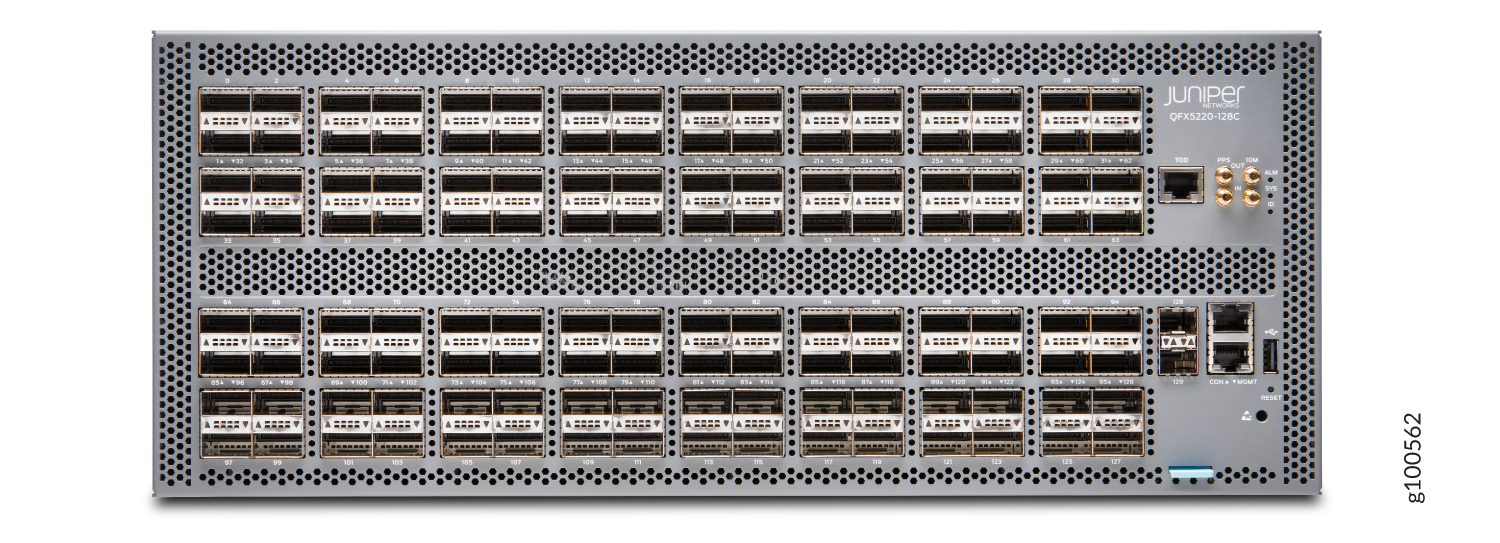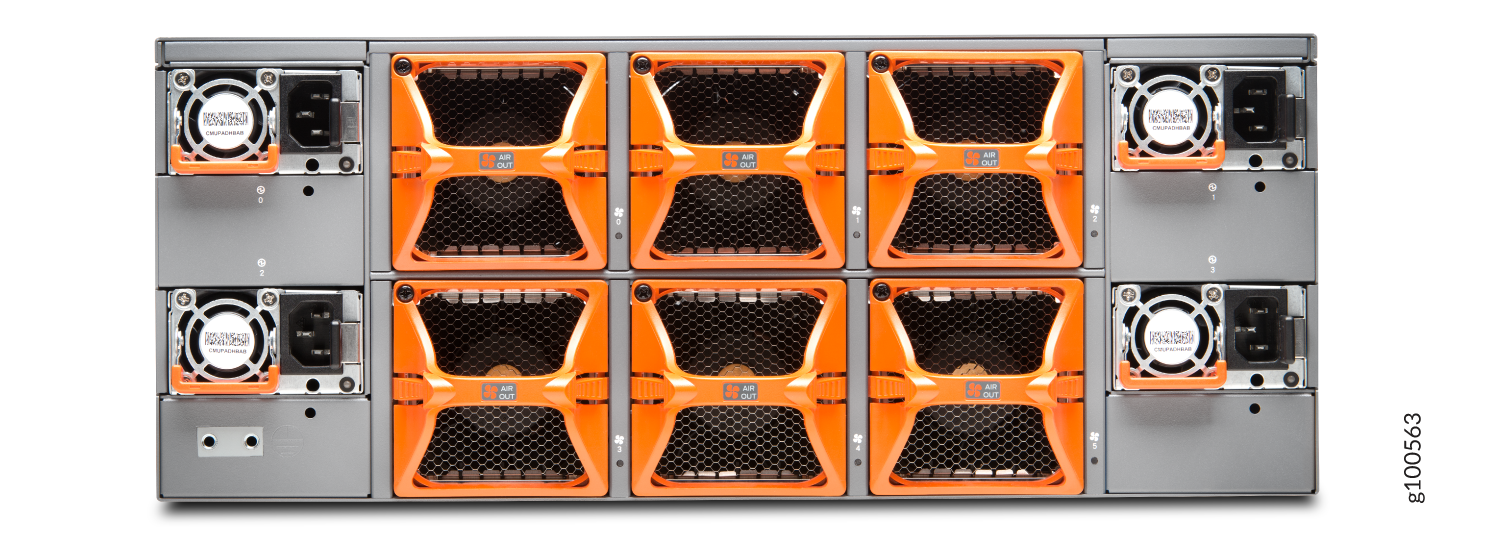QFX5220 System Overview
The QFX5220 line of switches offer two models for environments requiring 100-Gigabit Ethernet and 400-Gigabit Ethernet speeds.
QFX5220-128C Switch Description
The QFX5220-128C offers 128 ports of 100-Gigabit Ethernet in a 4-U form factor. With 12.8 terabits per second (Tbps) bandwidth, the QFX5220-128C is an optimal choice for spine-and-leaf IP fabric deployments as well as metro use cases. The 100-Gigabit Ethernet ports can be configured either for 100-Gbps or 40-Gbps speeds. The 100-Gbps ports can also be channelized into 4 x 25 Gbps or 4 x 10 Gbps. There are two dedicated small-form factor plugable plus (SFP+) ports for 10 Gigabit or 1 Gigabit Ethernet support.
An Intel Xeon D-1518 processor drives the QFX5220 control plane, which runs the Junos OS Evolved software. The Junos OS Evolved software image is stored on two internal 50-GB solid-state drives (SSDs). The QFX5220-128C is available with ports-to-FRUs airflow (Airflow Out) and with AC or DC power supplies.


Benefits of the QFX5220-128C
-
Serves the spine layer needs of a wide range of enterprises. Examples include: cloud and high-performance computing data centers; Software as a Service (SaaS) providers; streaming video service providers; cable operators; financial service providers and enterprises that run large-scale Web applications, analytics, and deep learning workloads.
-
Serves as a DC edge or DCI platform for metro MPLS use cases.
-
Supports IEEE 1588 Precision Time Protocol (PTP), Transparent Clock, and hardware timestamping for distributing precise time and frequency over packet networks. PTP is an important prerequisite in real-time sensitive workloads such as those employed in financial trading, real-time video streaming, and broadcasting networks.
-
Aligns well with the needs of environments whose aggregate traffic comprises lossless classes of traffic such as access to a remote flash storage, support for advanced congestion control, and flow-aware traffic scheduling support.
-
Supports zero touch provisioning at the ports, which automates provisioning and deployment with minimal manual intervention, saving time and effort for network operators.
-
Provides improved power efficiency and lowered costs per 100-Gigabit Ethernet port making this the industry best-in-class solution to support ever-expanding bandwidth needs.
QFX5220-32CD Switch Description
The QFX5220-32CD offers 32 ports of 400-Gigabit Ethernet in a low-profile 1-U form factor. With 12.8-Tbps bandwidth, the QFX5220-32CD is an optimal choice for very large, dense, and fast spine-and-leaf IP fabric deployments, as well as metro use cases. The high-speed ports support a wide variety of port configurations that include speeds of 400 Gbps, 100 Gbps, 25 Gbps, 40 Gbps, and 10 Gbps.
An Intel Xeon D-1500 processor drives the QFX5220 control plane, which runs the Junos OS Evolved software. The Junos OS Evolved software image is stored on two internal 50-GB solid-state drives (SSDs).
The QFX5220-32CD is available with either ports-to-FRUs or FRUs-to-ports airflow and with AC or DC power supplies. See Figure 3 and Figure 4.


Benefits of the QFX5220-32CD
-
Reduces compute-intensive workloads for hyperscale cloud and high-performance computing (HPC) data centers. Examples of these compute-intensive workloads include AI, machine learning, deep learning applications, and storage disaggregation workloads such as Non-Volatile Express over Fabrics (NVMe over Fabrics).
-
Enables data center re-architecture with flattened pods that slash switch hop latency.
-
Serves as a DC edge or DCI platform for metro MPLS use cases.
-
Enables a fast response by demanding applications, such as those encountered in financial exchanges by reducing intracluster switch latency.
-
Allows current Junos OS users to seamlessly migrate to Junos OS Evolved Linux software. With Junos OS Evolved, you can run Linux using your familiar Junos OS CLI, and run third-party Linux applications with Juniper Extension Toolkit (JET) API support, telemetry support for monitoring the DC network, and support for module-level in-service software upgrade (ISSU).
-
Saves you energy costs by highly reducing power consumption per Gbps of network traffic passing through the switch.
-
Provides an extensive roadmap to new features and functions, such as:
-
Advanced Precision Time Protocol (PTP) support (enhanced mirroring with PTP) for running real-time analytics on network flows
-
Comprehensive Remote Direct Memory Access over Converged Ethernet version 2 (RoCEv2)
-
Advanced congestion control and flow-aware traffic scheduling
-
Support for container networking and segment routing
-
Scale-out load balancing and multipathing
-
Support for advanced network instrumentation adopted by cloud data centers
-
QFX5220 Hardware Component Overview
The QFX5220 supports the components listed in Table 1.
|
Component |
Chassis Model |
Spare Juniper Model Number |
CLI Output |
|---|---|---|---|
|
Chassis |
QFX5220-32CD QFX5220-128C |
QFX5220-32CD-CHAS QFX5220-128C-CHAS |
QFX5220-32CD QFX5220-128C |
|
Fan module |
QFX5220-32CD
QFX5220-128C |
QFX5220-32CD-FANAI (FRUs-to-ports airflow) QFX5220-32CD-FANAO (ports-to-FRUs airflow)
QFX5220-128C-FANAO |
Note:
The QFX5220-128C is not available in AFI airflow.
|
|
Power supplies |
QFX5220-32CD |
JPSU-1600W-1UACAFI (FRUs-to-ports airflow) JPSU-1600W-1UACAFO (ports-to-FRUs airflow) JPSU-1600W-1UDCAFI (FRUs-to-ports airflow) JPSU-1600W-1UDCAFO (ports-to-FRUs airflow) |
|
|
QFX5220-128C-AFO |
JPSU-1600W-AC-AFO JPSU-1600W-DC-AFO |
Note:
The QFX5220-128C is not available in AFI airflow. |
System Software
The Junos OS Evolved software on the QFX5220 provides Layer 2 and Layer 3 switching, routing, and security services. Junos OS Evolved is installed on the switch solid-state drive (SSD).
For more information about which features are supported on QFX Series devices, see Feature Explorer.
You manage the switch using the Junos OS CLI, accessible through the console and out-of-band management ports on the device.
The QFX5220-32CD is supported on Junos OS Evolved Release 19.1R1 and later. The QFX5200-128C is supported on Junos OS Evolved Release 19.2R1 and later.
The DC version, QFX5220-32CD-D, is supported on Junos OS Evolved Release 19.3R1 and later.
QFX5220 Component Redundancy
The following hardware components provide redundancy on a QFX5220 switch:
-
QFX5220-32CD power supplies—The QFX5220-32CD switches have one or two power supplies. Each power supply provides power to all components in the switch. If two power supplies are installed, the two power supplies provide full power redundancy to the device. If one power supply fails or is removed, the second power supply balances the electrical load without interruption.
To provide power redundancy to the system, both power supplies must be installed. Connect power source feed A to one power supply and power source feed B to the second power supply.
CAUTION:Do not connect feed A and feed B to the same power supply input terminal.
-
QFX5220-128C power supply modules—The QFX5220-128C switches support a maximum of four power supplies, and offer 2 + 2 redundancy. If all four power supplies are installed, they provide full power redundancy to the device. If one power supply fails in a fully redundant system, or is removed, the other power supplies balance the electrical load without interruption.
The system can also run on two power supplies without redundancy. You must follow these guidelines if you install only two power supplies:
-
If you install a power supply in slot 0, you must install the second power supply in slot 2 or 3, and not in slot 1.
-
If you install a power supply in slot 1, you must install the second power supply in slot 2 or 3, and not in slot 0.
-
-
QFX5220-32CD cooling system—The QFX5220-32CD switch models have six fan modules and can operate with one fan not in operation (5+1 redundancy). If more than one fan module fails and is unable to keep the QFX5220-32CD within the desired temperature thresholds, chassis alarms occur and the QFX5220-32CD switch can shut down.
-
QFX5220-128C cooling system—This switch model has 12 fans in 6 fan modules. There is one fan out of the 12 fans for redundancy. This is known as (5x2+1)+1 redundancy). Any additional fan failures cause the switch to overheat, chassis alarms to occur and shutdown the switch.
QFX5220 Field-Replaceable Units
Field-replaceable units (FRUs) are components that you can replace at your site. The QFX5220 device FRUs are hot-insertable and hot-removable: you can remove and replace one of them without powering off the switch or disrupting the switching function.
Replace a failed power supply with a new power supply within 3 minutes of removal to prevent chassis overheating. The QFX5220-32CD switch continues to operate with only one power supply running. The QFX5220-128C can operate with only two power supplies running. For best performance, we advise replacing failed power supplies and fan modules as quickly as possible to protect against another failure.
Table 2 lists the FRUs for the QFX5220 device and actions to take before removing them.
|
FRU |
Required Action |
|---|---|
|
Power supplies |
None. |
|
Fan modules |
None. |
|
Optical transceivers |
None. We recommend that you disable the interface using the set interfaces interface-name disable command before you remove the transceiver. |
If you have a Juniper Care service contract, register any addition, change, or upgrade of hardware components at https://www.juniper.net/customers/support/tools/updateinstallbase/. Failure to do so can result in significant delays if you need replacement parts. This note does not apply if you replace existing components with the same type of component.
